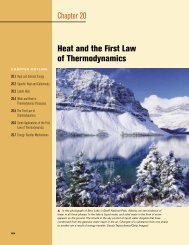15 • Oscillatory Motion - ECHSPhysics
15 • Oscillatory Motion - ECHSPhysics
15 • Oscillatory Motion - ECHSPhysics
Create successful ePaper yourself
Turn your PDF publications into a flip-book with our unique Google optimized e-Paper software.
O<br />
O<br />
O<br />
x<br />
v<br />
a<br />
T<br />
2<br />
T<br />
2<br />
T<br />
2<br />
(a)<br />
T<br />
T<br />
T<br />
3T<br />
2<br />
3T<br />
2<br />
3T<br />
2<br />
Figure <strong>15</strong>.8 (a) Position, velocity, and acceleration versus time for a block undergoing<br />
simple harmonic motion under the initial conditions that at t 0, x(0) A and v(0) 0.<br />
(b) Position, velocity, and acceleration versus time for a block undergoing simple harmonic<br />
motion under the initial conditions that at t 0, x(0) 0 and v(0) v i.<br />
our solutions for x(t) and v(t) (Eqs. <strong>15</strong>.6 and <strong>15</strong>.<strong>15</strong>) obey the initial conditions that<br />
x(0) A and v(0) 0:<br />
x(0) A cos A<br />
v(0) A sin 0<br />
These conditions are met if we choose 0, giving x A cos t as our solution. To<br />
check this solution, note that it satisfies the condition that x(0) A, because<br />
cos 0 1.<br />
The position, velocity, and acceleration versus time are plotted in Figure <strong>15</strong>.8a for<br />
this special case. The acceleration reaches extreme values of 2 A when the position<br />
has extreme values of A. Furthermore, the velocity has extreme values of A,<br />
which both occur at x 0. Hence, the quantitative solution agrees with our qualitative<br />
description of this system.<br />
Let us consider another possibility. Suppose that the system is oscillating and we<br />
define t 0 as the instant that the particle passes through the unstretched position<br />
of the spring while moving to the right (Fig. <strong>15</strong>.9). In this case we must require that<br />
our solutions for x(t) and v(t) obey the initial conditions that x(0) 0 and<br />
v(0) v i :<br />
x(0) A cos 0<br />
v(0) A sin v i<br />
The first of these conditions tells us that /2. With these choices for ,<br />
the second condition tells us that A v i/. Because the initial velocity is positive<br />
and the amplitude must be positive, we must have /2. Hence, the solution is<br />
given by<br />
x v i<br />
t<br />
t<br />
t<br />
cos <br />
<br />
t <br />
2 <br />
The graphs of position, velocity, and acceleration versus time for this choice of<br />
t 0 are shown in Figure <strong>15</strong>.8b. Note that these curves are the same as those<br />
in Figure <strong>15</strong>.8a, but shifted to the right by one fourth of a cycle. This is described<br />
mathematically by the phase constant /2, which is one fourth of a full cycle<br />
of 2.<br />
O<br />
O<br />
O<br />
x<br />
v<br />
a<br />
T<br />
2<br />
T<br />
2<br />
T<br />
2<br />
SECTION <strong>15</strong>.2 <strong>•</strong> Mathematical Representation of Simple Harmonic <strong>Motion</strong> 459<br />
T<br />
T<br />
T<br />
(b)<br />
3T<br />
2<br />
3T<br />
2<br />
3T<br />
2<br />
t<br />
t<br />
t<br />
x i = 0<br />
t = 0<br />
v = v i<br />
x = 0<br />
Active Figure <strong>15</strong>.9 The<br />
block–spring system is undergoing<br />
oscillation, and t 0 is defined at<br />
an instant when the block passes<br />
through the equilibrium position<br />
x 0 and is moving to the right<br />
with speed v i.<br />
At the Active Figures link<br />
at http://www.pse6.com, you<br />
can compare the oscillations of<br />
two blocks with different<br />
velocities at t 0 to see that<br />
the frequency is independent of<br />
the amplitude.<br />
m<br />
v i



